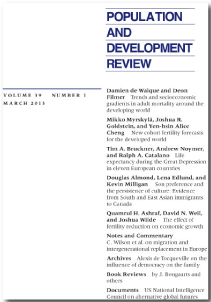
Dasgupta, A. and Dasgupta, P.
Socially Embedded Preferences, Environmental Externalities, and Reproductive Rights
Population and Development Review
Vol. 43(3) pp. 405-441 (2017)
Abstract: Among economists and demographers, the dominant view of the effect of growing human numbers on the natural environment has alternated between concern and dismissal. If in the years immediately following World War II scholars were anxious that population growth would retard economic development in poor countries, they have not worried in recent decades. A series of influential reviews of the modern growth experience (National Research Council 1986; Birdsall 1988; Kelley 1988; Temple 1999; Helpman 2004) studied cross-country data and saw a negligible link—possibly even a small positive link—between population growth and growth in per capita gross domestic product. These analyses were convincing, but the underlying assumption that economic betterment is best seen in terms of growth in GDP per capita should be questioned. The presence of the qualifier "gross" in gross domestic product signals that the measure does not record the depreciation of natural capital that can accompany the production of goods and services.1 Other things equal, depreciation of natural capital reduces a nation's productive capacity, the correct measure of which is an inclusive notion of wealth. And normative economics tells us that the index we should deploy for assessing the sustainability of human development is the wealth of nations (Arrow et al. 2012), not the GDP of nations, nor the Human Development Index of nations.
Author links: Partha Dasgupta
Publisher's Link: https://doi.org/10.1111/padr.12090 ![]()
Cambridge-INET Working Paper Version of Paper: Socially Embedded Preferences, Environmental Externalities, and Reproductive Rights, Dasgupta, A. and Dasgupta, P., (2017)
